Bay Curtain Poles & Tracks FAQ
Finding which bay curtain pole or track you need can feel daunting with all the options available.
So to help you we've put together the ultimate list of questions and answers.
- What's better for a bay window, a curtain pole or track?
- Which curtain headings are suitable for bay window curtain poles?
- Which curtain headings are suitable for bay window curtain tracks?
- Why is there such a difference in price between different bay curtain tracks/poles?
- How do I measure for my bay pole or track?
- How do I find the right size bay curtain pole or track?
- Does the overall length of your bay poles include finials?
- How does a bay window curtain pole work and what are the different bracket styles?
- Why are there different corner joiner types?
- Are there bay curtain poles for eyelet curtains?
- What shape/angle bay windows are curtain poles suitable for?
- What choices do I have if my bay has 5 or more sides?
- What bay curtain poles are suitable for tall bay windows?
- Can bay curtain poles be fixed to the ceiling?
- Can a bay curtain pole return back into the room?
- How do you make a pole return if a kit isn't available?
- Can bay poles or tracks be corded?
It depends on your circumstance and what you are trying to achieve.
Generally though, the main differences to consider are:
- Bay curtain poles - are usually more decorative with more choice, however often dearer and they usually require more assistance when opening/closing due to their design.
- Bay curtain tracks - are usually smoother, functional and often more affordable.
If you're after enhancing the look of your curtains within your room, then a curtain pole is the ideal choice - and if you go for a quality bay curtain pole, you'll find they can be nearly as smooth as a curtain track.
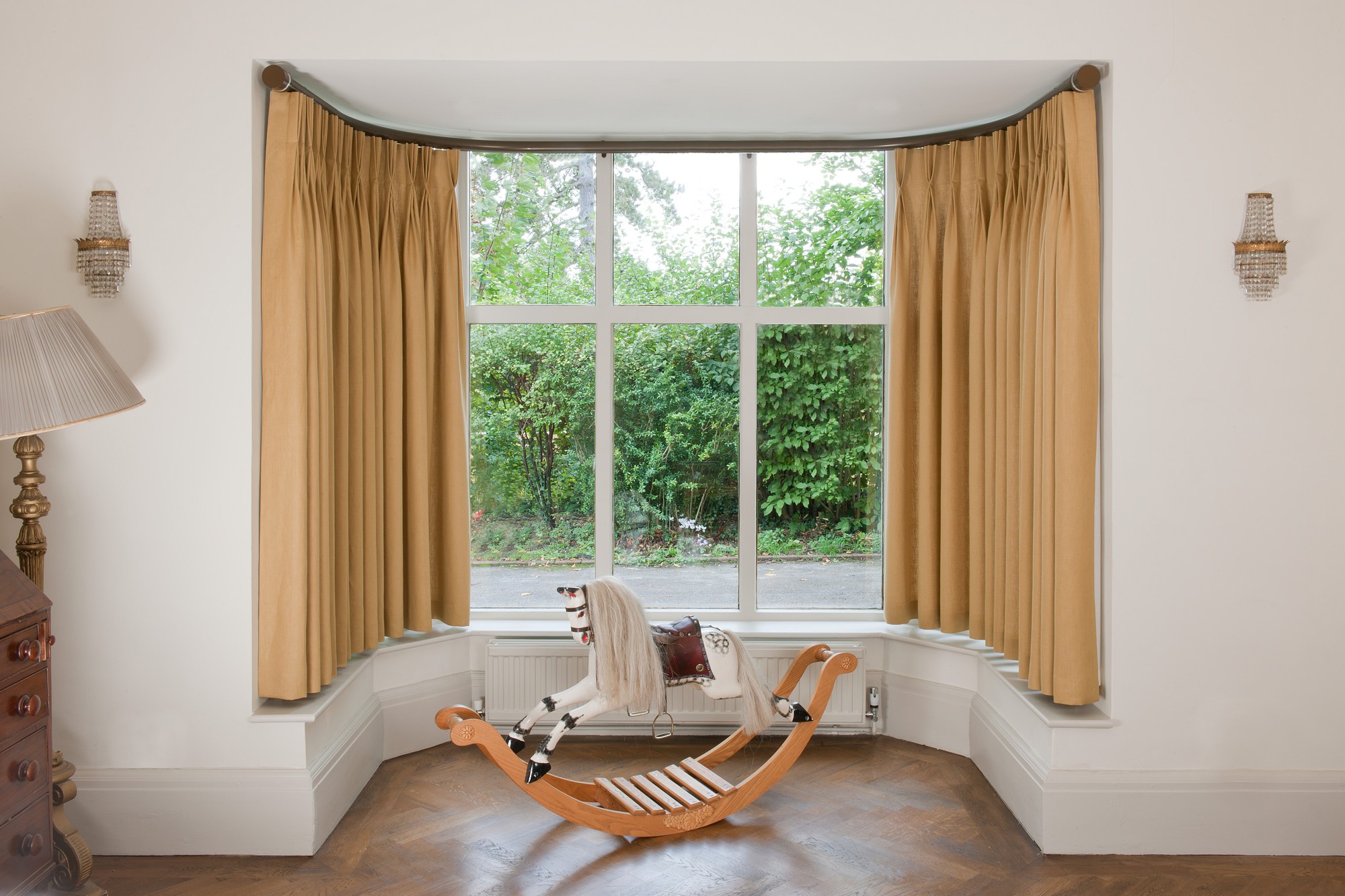
Curtain poles are even more versatile for bay windows, suitable for pencil pleat, pinch pleat, duo pleat, goblet pleat, wave heading (wave heading only suitable with specially designed wave compatible poles) and eyelet curtains.
Due to differences between bay curtain poles not all bay poles are suitable for all headings so be careful to select the correct type when purchasing.
Fortunately, we offer a solution for most bay windows. In the other questions on this page we explain the differences between bay poles.
To browse without having to read everything in this FAQ here are some quick links filtered by the suitable heading type, which will show you poles suited for the correct curtain heading:
- Bay poles for pleated curtains
- Bay poles for eyelet curtains
- Bay poles for tab-top curtains
- Bay poles for wave curtains
Curtain heading suitability for bay curtain poles
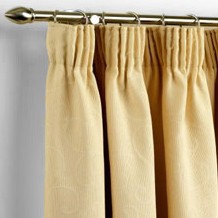
Pencil Pleat
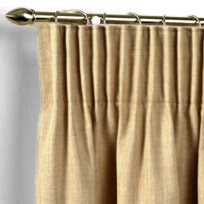
Deep Pencil Pleat
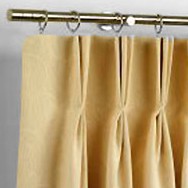
Triple Pinch
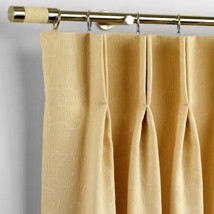
Double Pinch
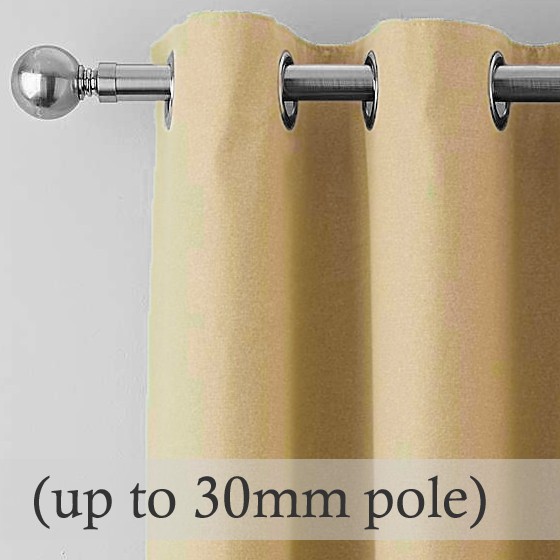
Eyelets
Sometimes suitable (see link above)
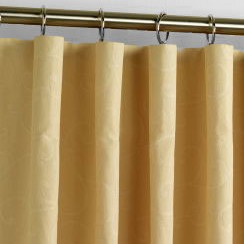
Cartridge
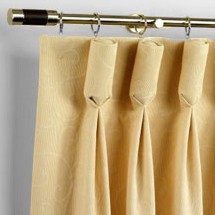
Goblet
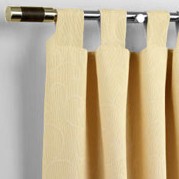
Tab Top
Sometimes suitable (see link above)
Don't forget, we also sell made to measure curtains from our vast array of curtain fabrics - take a browse for an online quote or contact us and we can help advise you.
Curtain tracks for bay windows are quite versatile as to which headings you can hang from them.
They're suitable for most headings like pencil pleat, pinch pleat, duo pleat, goblet pleat & wave heading (wave heading only suitable with specially designed wave compatible tracks).
However, you cannot use curtain tracks for eyelet or tab top curtains as the brackets get in the way of the curtains.
Curtain heading suitability for bay curtain tracks

Pencil Pleat

Deep Pencil Pleat

Triple Pinch

Double Pinch

Eyelets
Not usually suitable

Cartridge

Goblet

Tab Top
Not usually suitable
Curtain tracks are usually more affordable than curtain poles as they're more functional in their design.
Bay curtain tracks/poles themselves can vary in price, the reasons for this are similar to the normal reasons poles & tracks vary in price, but with bay poles & tracks the other factors which affect price, and usually quality are:
In the below questions you can find out in more detail about the differences on the above points.
There are two ways of measuring for your bay curtain pole/track:
- Measure the existing pole/track
- Measure the recess of your windows and this will assist in getting the overall length of your bay
If you need help measuring your bay you can download our bay window measuring guide.

Many of the available bay curtain poles or tracks are sold in preset sizes, whereby you can cut them down to the size required for your bay window.
Therefore, when looking for a pole or track if you cannot find the exact size you should choose the next size up and cut it down using a hacksaw.
Some poles or tracks are made to measure, mainly the Silent Gliss brand. These don't require cutting down as they are factory bent to your exact bay window measurements. You state the overall length when ordering and how many angles your bay has and our team of experts will contact you back to assist you with measuring your bay to finalise the order.
For further advice on how to measure your bay window, please refer to our bay measuring guide.
With most of our bay curtain poles the finials are excluded from the overall length. The one exclusion to this rule is our made to measure range which allows you to either select the length to include or exclude finials in the measurement, however this will be specified within the options on the product when ordering.
Bay curtain poles are different to standard straight poles, generally with specifically designed brackets, rings or gliders.
The difficulties of drawing curtains on bay windows is ensuring the pole is fully supported throughout the bay at the same time as allowing the rings/gliders to slide freely to allow the curtains to be fully opened or closed.
There are several different bay pole types, each with their own advantages:
Bay poles with passing rings/brackets
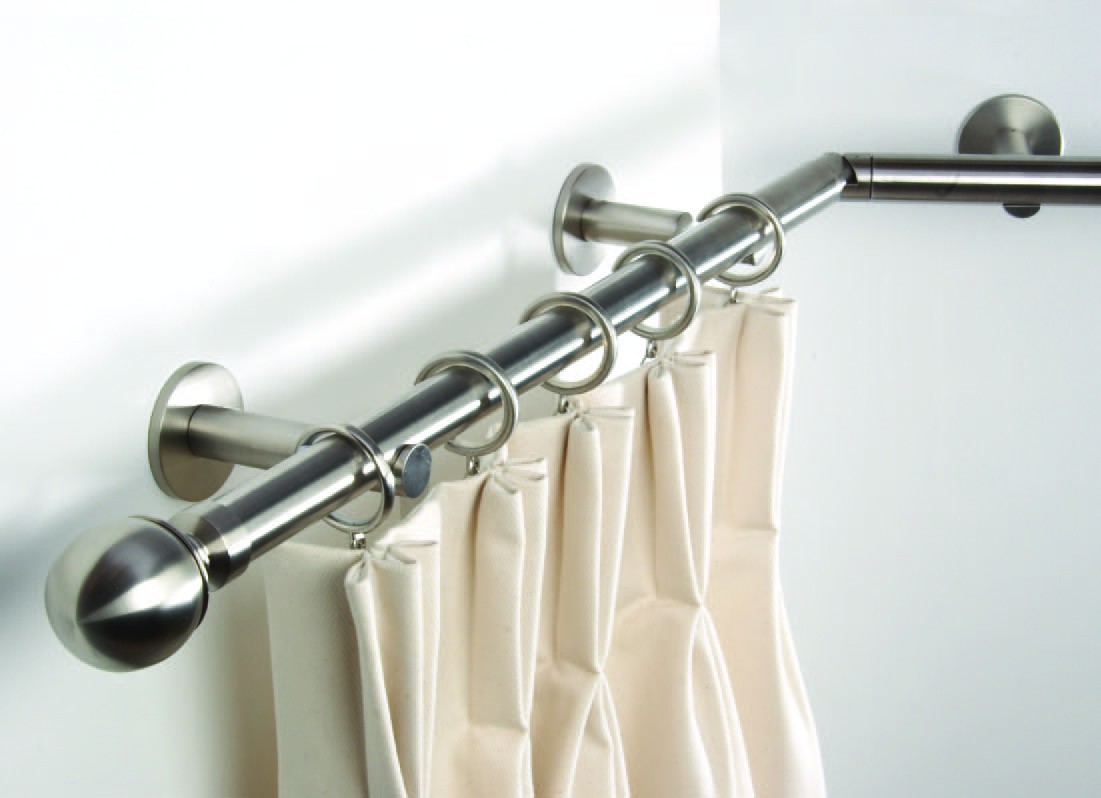
Passing brackets and passing rings (sometimes referred to as passover brackets and c-rings) are one of the more popular and original methods for a bay curtain pole.
The specially designed bracket often has the front edge protruding less than a standard bracket and the passing rings are a 'C shape' with a cut out notched section at the back to allow them to pass over the bracket.
The passing brackets are used in combination with standard brackets; usually three standard brackets (one either end and a central bracket) along with a passing bracket at each corner to support the pole.
Advantages and disadvantages of passing rings/brackets
Suitable for small to large bays - Passing rings and brackets can, in theory, be used to infinitely extend a bay pole for as many sides as required, often with special return kits to allow you to return your pole into the room.
Great value - This is often one of the better value ways of having a curtain pole at a bay window.
Smoother options available - Due to the nature of the passing rings having to slide over the bracket it's not always as smooth as some of the other systems available. The curtains tend to be best drawn by ensuring they stay in a vertical hanging position, either using a draw rod or pulling directly from underneath making sure they don't angle, otherwise the passing rings are liable to catch on the passing brackets.
Not suitable for eyelet/tab top headings - The passing brackets will prevent any eyelet or tab top headings from going past the brackets and being fully drawn open/closed on these types of bay poles.
View bay curtain poles with passing brackets
Tunnel brackets for indirect support
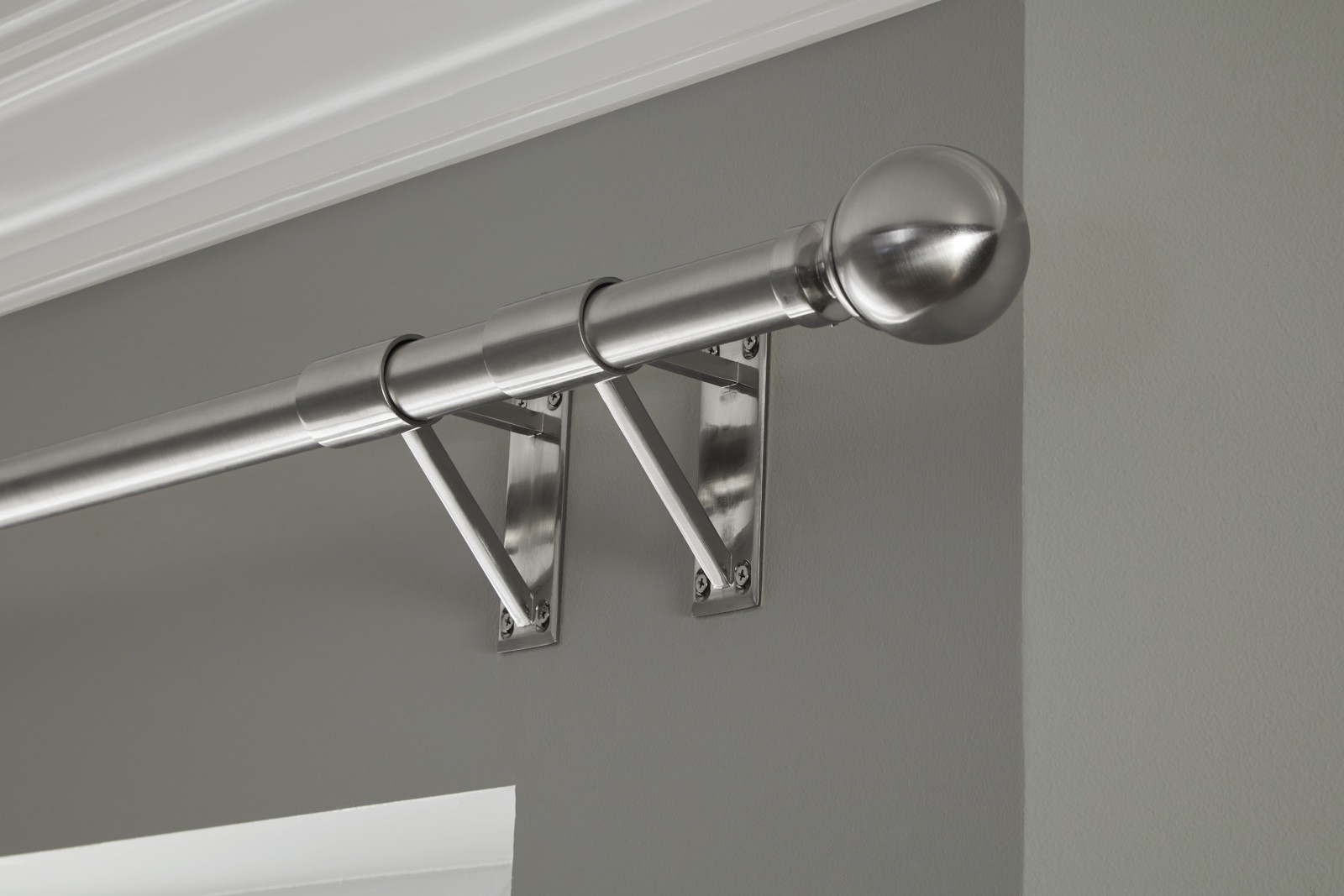
Some bay poles use a 'tunnel bracket' at either end to allow an indirect (or cantilever) support of the corners negating any need for brackets at the corner of the bay pole.
Generally, they are sold with three or five tunnel brackets; one or two either end and a central bracket.
Advantages and disadvantages of tunnel brackets
Smooth opening/closing - The corners don't require direct support from a corner bracket allowing the use of normal rings which slide more freely than bay poles using passing rings/brackets. This means you can draw the curtain more easily without the risk of rings catching on any corner brackets (like can happen with passing rings/brackets).
Usually suitable for eyelets/tab top headings - The pole doesn't have any brackets at the corners which usually makes it suitable for eyelet or tab top curtains (preferably if the corner piece is a notched corner joiner).
Only suitable for up to three sided bays - These are limited to three-sided bay windows (two angle bends) as any more sides wouldn't be given enough support at the corners.
View bay poles with tunnel brackets for indirect support
Metropoles that use a glider system
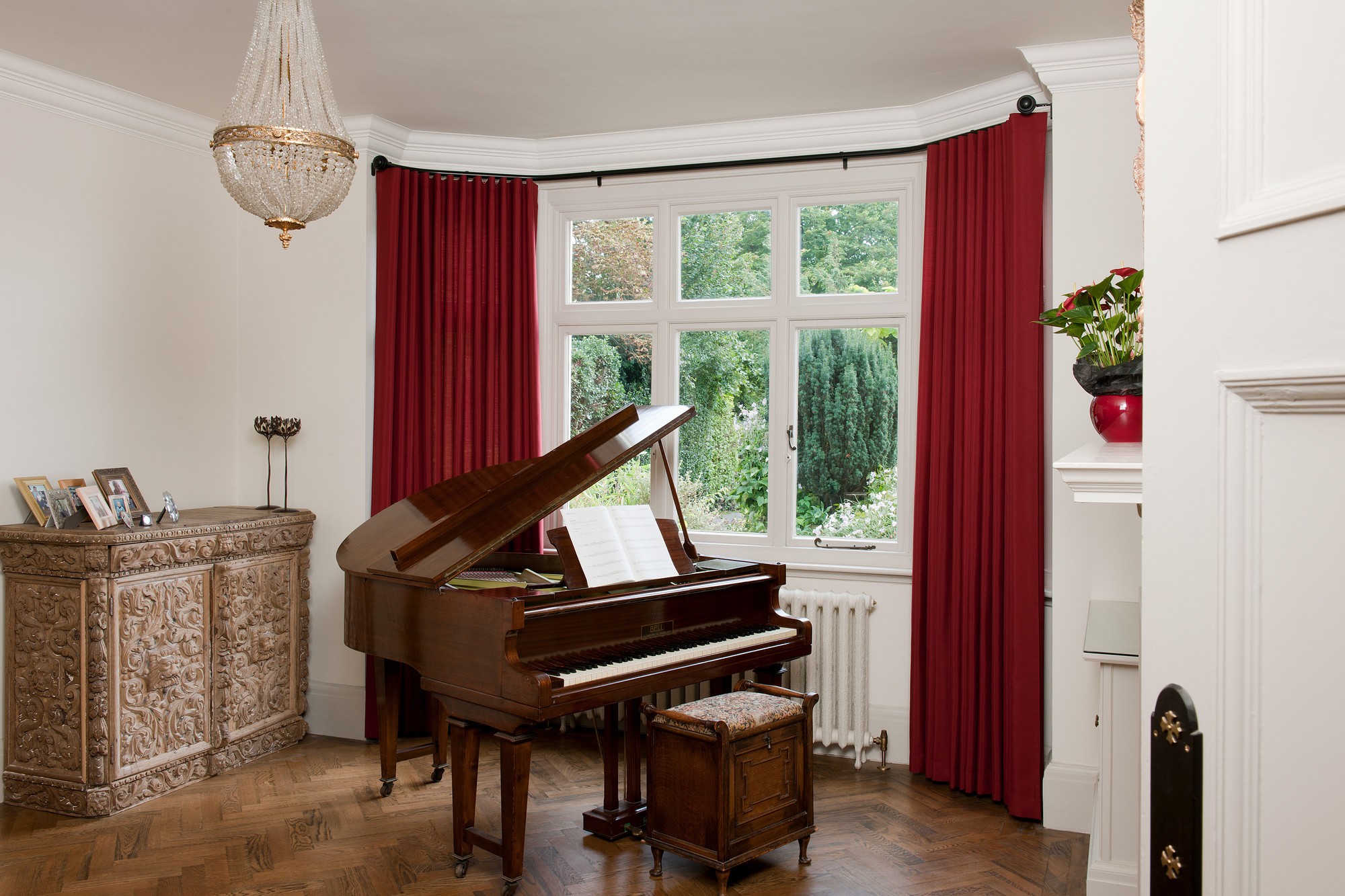
Silent Gliss Metropoles are a range of hybrid made to measure curtain poles that use a track glider system.
Silent Gliss products are all made to measure to high standards, with their aim to be smooth drawing curtain poles that are called Metropoles.
Their appearance is like a pole without any rings as it uses gliders just like a track. Similarly to a track, the brackets connect to the top of the Metropole and spaced at intervals of approximately 60cm apart (varies dependent upon product), with as many as required for the length of the Metropole.
Advantages and disadvantages of Metropoles with gliders
Smoothest opening/closing - Metropoles are usually the smoothest type of bay pole as it uses gliders that are not obstructed by the brackets or bends.
Wide range of colours and styles - It has one of the widest choice of colours and finial styles available.
Hand-drawn or corded - Due to its track-like nature it can be hand-drawn or in many cases Metropoles can be corded.
Unlimited length & bends - Practically unlimited number of brackets or bends so can be used in nearly any type of bay window. If you need something different than our website allows just contact us for advice.
Factory bent - When the Metropole is made the angles are bent in the factory and incredibly smooth as a result. They are made to measure and to place an order we would contact you with a bay measuring form and guide you through the measuring process.
Premium quality - This tends to be a more premium price product, however, many people find once they've tried a Metropole and found it to be so smooth that they wouldn't settle for a traditional bay pole ever again.
The corners or corner joiners on a bay pole are a key component and very often make the difference in a bay pole feeling good quality or not when drawing your curtains. The better corner joiners make it easier when opening or closing your curtains.
All bay poles will use some form of a corner joiner, but they're not all created equal, below you will find some of the advantages and disadvantages of each type.
Single elbow joiners or knuckle joiners
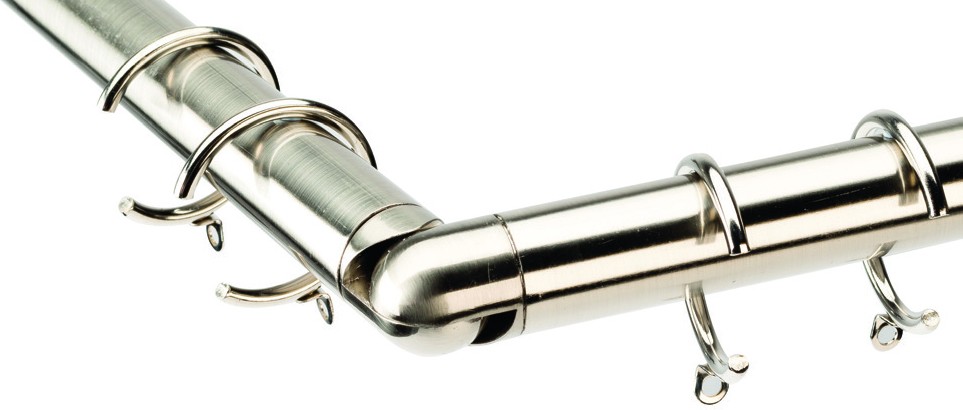
Usually suitable up to 135/45 degree corner angles, these are one of the most common types mainly due to being a low cost method of allowing the rings to go around the corners in the bay in a relatively smooth way.
Although you can feel a slight notch when the rings pass over the corner piece due to the join between the corner and straight length of the pole, there are ways to help mitigate this.
It's best to help the rings pass over by assisting your curtains around the corner either by holding the curtains near the heading and guiding them around or by using a curtain draw rod which attaches to the back of the curtain heading and allows you to reach higher more easily.
Also be sure when fitting these that the screws in the elbow joiner face downwards so the screws avoid the rings catching on them as they pass-over.
Double elbow joiners or knuckle joiners
Double elbow joiners are similar to the above elbow joiners but there are two of them spaced with a short 10cm section of pole in between, which allows them to be used on angles of up to 90 degrees (sometimes referred to as a square bay window).
Sometimes these are sold within a bay pole kit, or alternatively you can purchase additional elbow joiners, cut a short piece of pole off and create your own. This could allow you to convert a single elbow joiner into a double to accommodate a tighter bay angle.
Snake elbow joiners
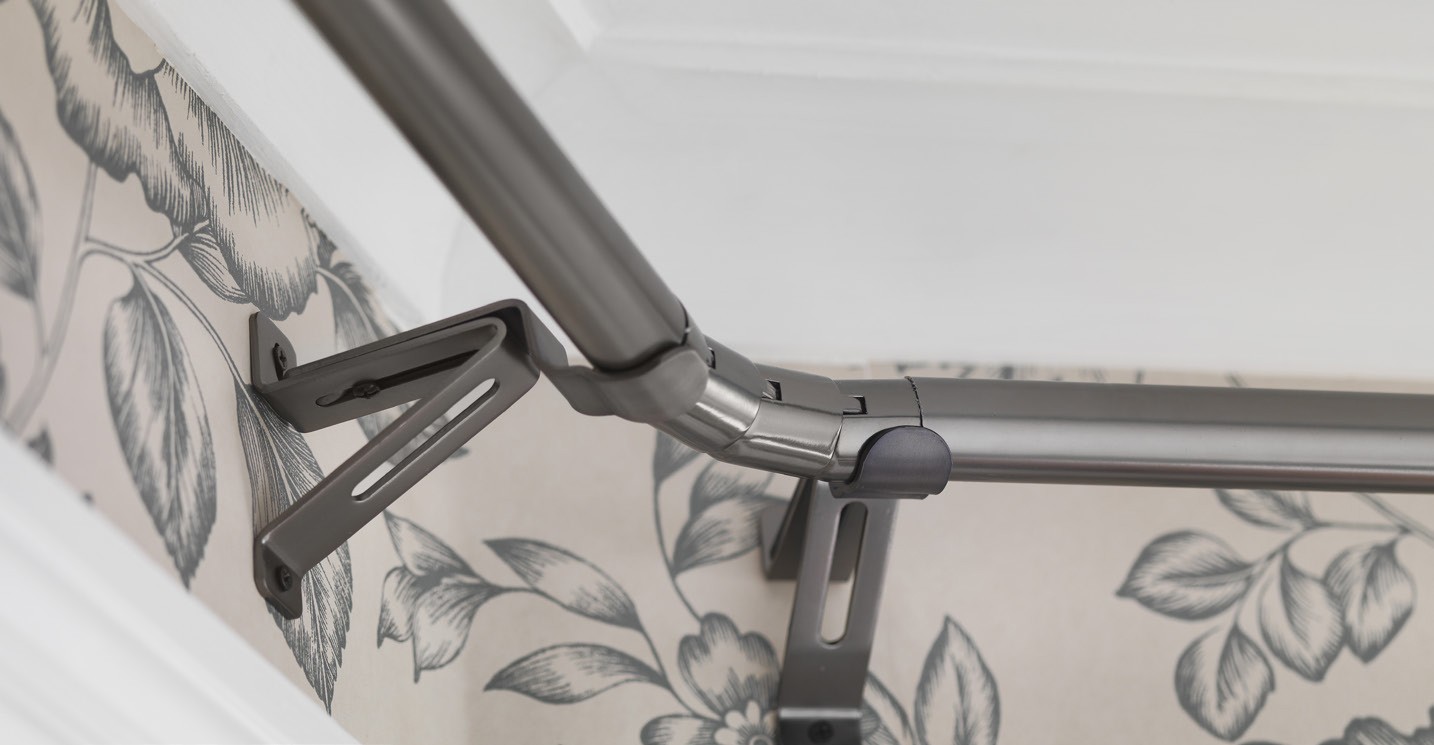
Using a similar principle to a double elbow joiner to create a smoother corner join. By having more, usually smaller, angle joiners connected together up to 90 degrees (or a square bay) can be accommodated.
Similarly to single/double elbow joiners these are often helped by assisting your curtains around the corner as the rings pass over the joiners where the joiners connect.
To do this use the same methods as explained above for single elbow joiners of holding the curtains near the heading or using a draw rod. Also like elbow joiners, ensure to have the screws facing downwards so the rings don't catch as they pass-over (however the image above shows the other way for aesthetic reasons).
Notched corner joiners

A smoother type of corner joiner, often found in the better quality bay poles you can expect to pay a little more for this.
These usually allow up to 90 degree corner angles and can be bent easily to the angle you require, without any screws required to tighten they just hold in place.
As the gaps between the notches are tighter than elbow joiners there's minimal friction as the rings pass-over the corner.
They are usually easier to draw your curtains around and don't require as much assistance around the corner unlike elbow joiners.
Made to measure poles with factory bent corners
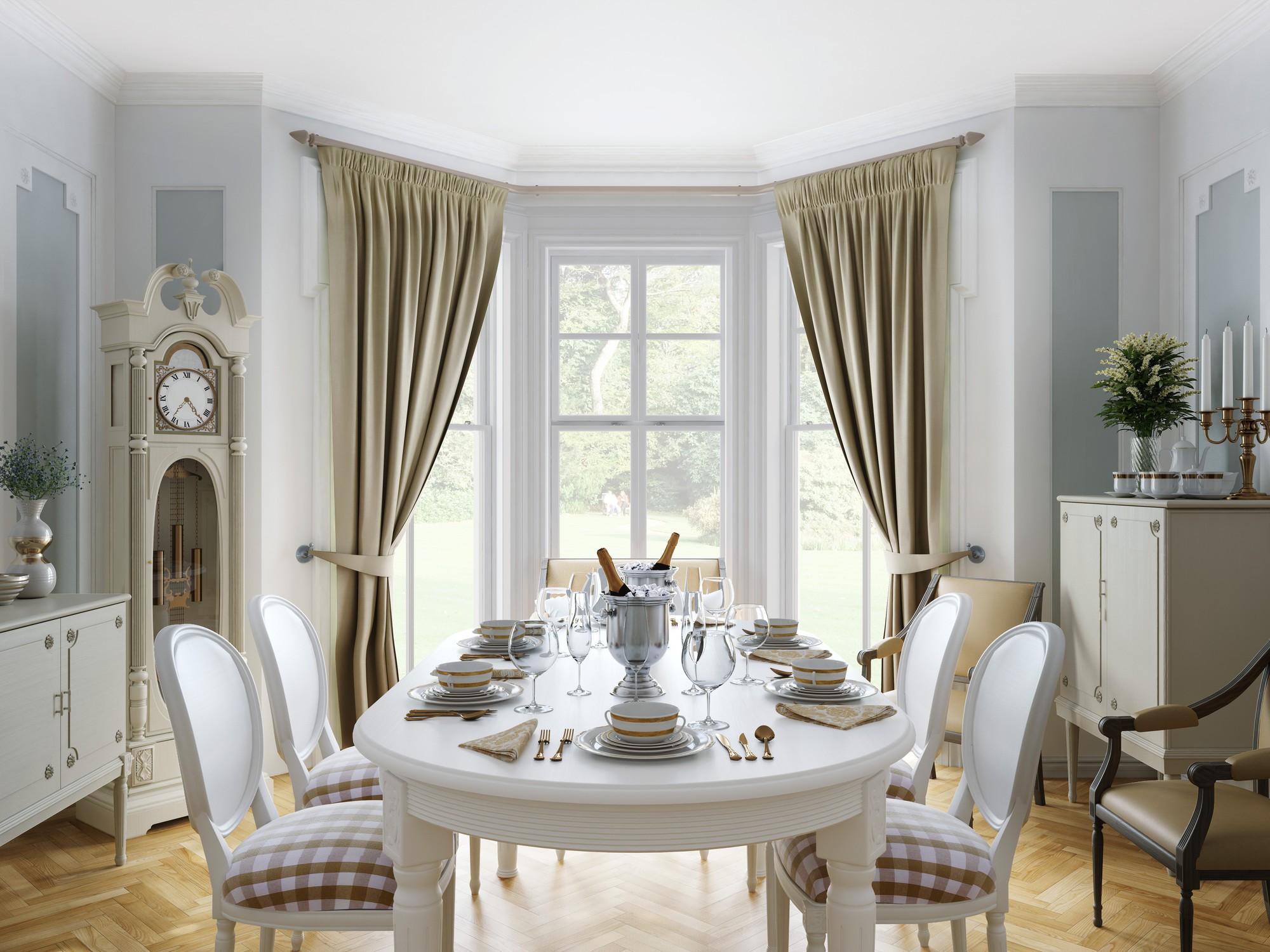
The smoothest type of corner joiner for a bay pole. These are usually only found on poles using a glider system (without rings) like Silent Gliss Metropoles and make for a very high quality pole.
The pole is usually in one continuous length (sometimes two) and the corners are factory bent to your exact bay angles.
There aren't any notches and using a track-style glider system the curtains draw around the pole as smooth as a straight curtain pole. This makes it the most natural type of bay pole to use as there isn't any additional need to assist the curtains past the corners like elbow joiners or notched joiners.
It also is one of the easier bay poles to fit as it comes to the exact size and shape when it arrives.
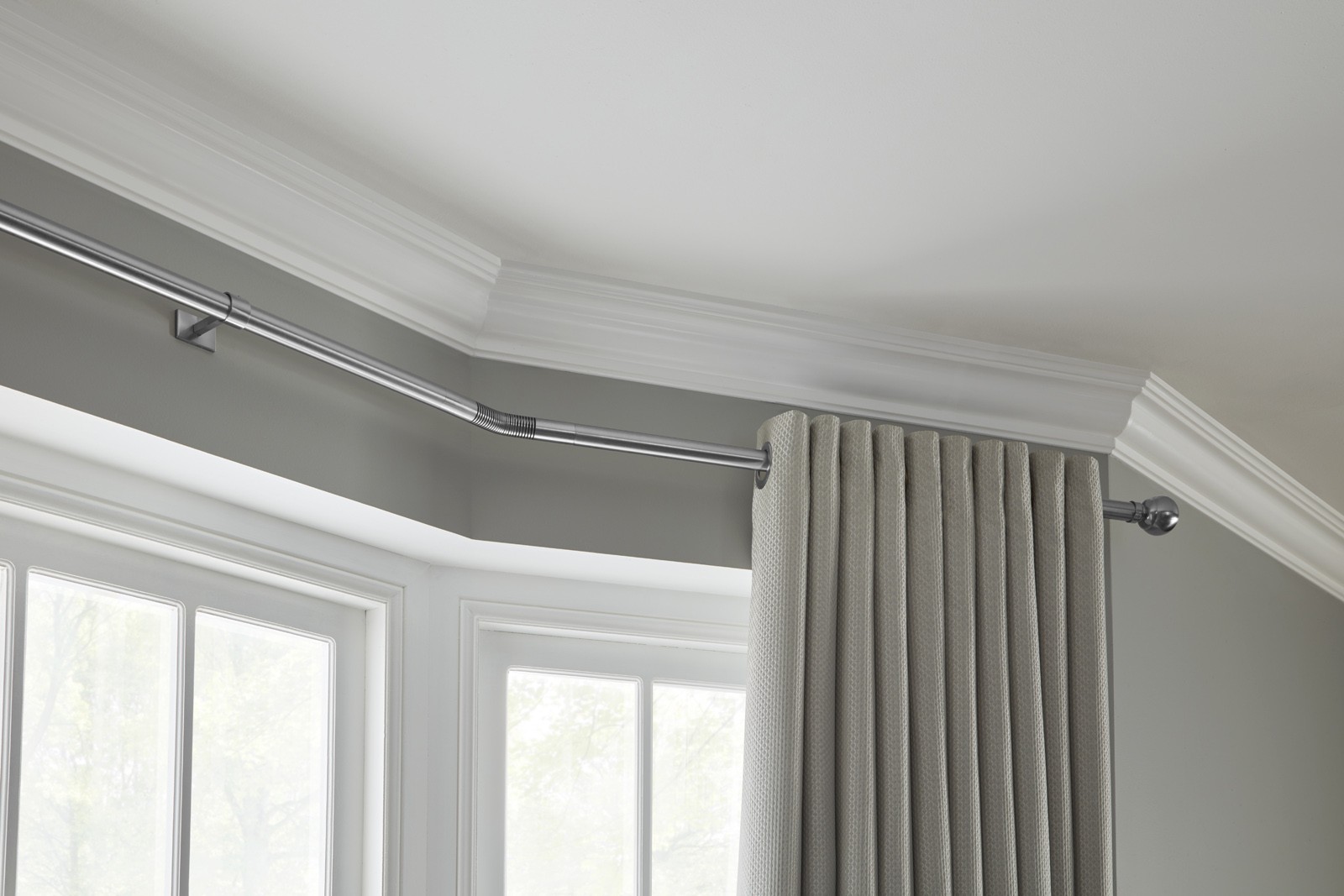
Yes, providing you select the right type of pole - fortunately, we have plenty of eyelet bay curtain poles to choose from. You can view our eyelet bay curtain poles right here or read on as to how they work.
In order to allow eyelet curtains to draw around a bay window, the pole needs to only use brackets at either and in the centre of the pole, however they use specially designed brackets.
These types of poles use brackets to support the corners indirectly usually due to the bracket being a 'tubular' bracket, often using 2 brackets at each end of the pole for extra support in the corners.
The corners themselves are not supported by any brackets directly, but by a cantilever action. This is the key to ensuring your curtains can draw fully around the bay window as nothing interferes with the eyelets of your curtains as you draw them.
Example bracket positioning for eyelet curtains

Due to the nature of these poles, they are usually only suitable for three-sided bay windows.
Most eyelet curtains are suitable for 28mm poles as they have an internal diameter of 40mm, however, some eyelets are slightly larger with 50mm internal diameter and those are suitable for our ranges of 35mm eyelet bay curtain poles.
One benefit of eyelet curtains on bay poles is that they can take heavier curtains. This is because most eyelets are metal and many of the rings nowadays are lined with a plastic inner, and whilst the plastic lining on rings makes them quiet, it results in more friction and therefore you can't use as heavy curtains.
Bay windows are in a variety of shapes and you need to be careful choosing the right curtain pole. For instance if you have a 'square' bay with 90-degree angles, not all the corner joiners will be suitable.
To learn more about the corner joiners mentioned below see the question Why are there different corner joiner types?
Below are the various bay shapes and the usual bay poles suitable for them:
Square bay window (90-degree right-angle bends)
Bay poles that are suitable for square bay windows or windows with 90-degree right-angle bends are made suitable by the type of corner joiner, which must be specific so that it's not too tight an angle for the rings to slide over the corner.
Square bay window:

The corner joiners suitable will be either:
- Two elbow joiners with a 10cm section of pole between them, creating 2 x 45-degree bends
- A snake-type elbow corner consisting of several elbow joiners connected together to allow a gradual curve
- A notched corner joiner which is bent by hand but very smooth
- Factory bent corner on a made to measure pole
View our bay poles suitable for square / 90-degree angles
Splay bay window (135-degree angle bends)
A bay pole for a splay window of an angle of 135 degrees approx, which is one of the more common types of a bay window.
Splay bay window:

As this is quite a wide angle generally any type of bay pole is suitable for this.
View our bay poles suitable for 135-degree angles
Bow bay window (gradual curve angle bends)
If your bay window has a gradual curve or five or more sides then you have fewer choices:
- A bay pole with passing rings and passing brackets
- Factory bent corner on a made to measure pole
Five or more sides:
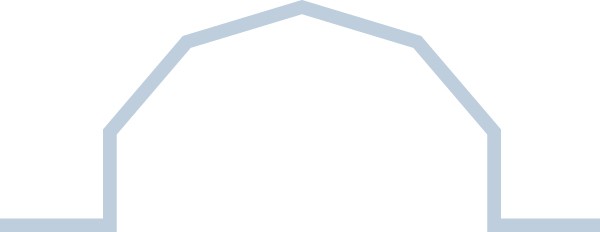
Bow/curved bay window:

Often due to the complexity with a bow window you often need to create your own pole from components & bay pole kits or have it completely made to measure. If you need any help with this please contact us for advice.
If you have a bay window with 5 or more sides you should look for specific bay pole types to ensure your curtains will draw around the bay and be fully supported.
Five or more sides:

Five-sided (or more) bay windows will require a pole with either:
- Passing rings & passing brackets
- Glider track system; such as a Silent Gliss Metropole which looks like a pole but works like a track
Passing rings/brackets
Using a pole with passing rings and brackets means you can also easily extend it or add more sides, as you simply keep adding another bracket for each additional side your bay window has.
Metropole glider system
A Metropole is a glider track system that looks like a pole, where the brackets connect to the top of the pole and the gliders slide below the pole. It's fully made to measure and factory bent, and because of this it's the smoothest type of bay pole you can have.
The Metropole can have nearly unlimited bends or even gradual curve bends as well as return bends into your room. The Metropole offers some of the best versatility on the market, although you do pay a little more once you've tried it you won't want to go back to a normal pole with rings.
Eyelet curtains
Unfortunately, if you have five or more sides you won't be able to use eyelet curtains if you want them to draw fully around the bay window.
We've conveniently made a section dedicated right here for 5 sided bay window poles.
Although tall bay windows may not require a longer curtain pole, because of their height there are several things to consider when choosing the right curtain pole.
As your bay becomes taller, or wider, the curtains are likely to get heavier so it's recommended to choose a better quality curtain pole to accommodate the weight.
Aside from the curtain weight, you should also consider other factors specific for tall windows:
The correct type of bay curtain pole
The higher your bay window, the more difficult it will be to 'assist' the curtain rings around the pole and its brackets, therefore it's recommended to use a pole that uses tunnel brackets for indirect support or a Metropole with gliders.
This will ensure you don't have difficulty with passing rings sliding over passing brackets will require the rings to be in the right position to pass-over the brackets.
Use draw rods to open/close your curtains
To further help mitigate issues of drawing your curtains around the bay you can use draw rods, connected to the top of your curtain heading which will help ensure that you aren't dragging your curtains around the bay with unnecessary pressure, which could lead to deforming/damaging your curtains or curtain pole.
By ensuring you draw your curtains from near the top, which a draw rod ensures, it reduces the pressure on the pole especially by avoiding angling your curtains.
Remember, the higher your bay window, the longer the draw rods that are recommended. Without draw rods, as the bay gets higher the more pressure will be put on your curtain pole.
Quite a number of bay poles can be fixed to the ceiling, but it's very much dependent upon the bracket being used.
If the bracket only projects the pole away from the ceiling a small amount then your choice of finals will be restricted, sometimes to just an end cap.
There are several styles of brackets which can be ceiling fixed, here are some examples:
- Passing rings & passing brackets
- Glider track system; such as a Silent Gliss Metropole which looks like a pole but works like a track
Using the filters on our site you can easily narrow down the choice to just ceiling fix bay poles.
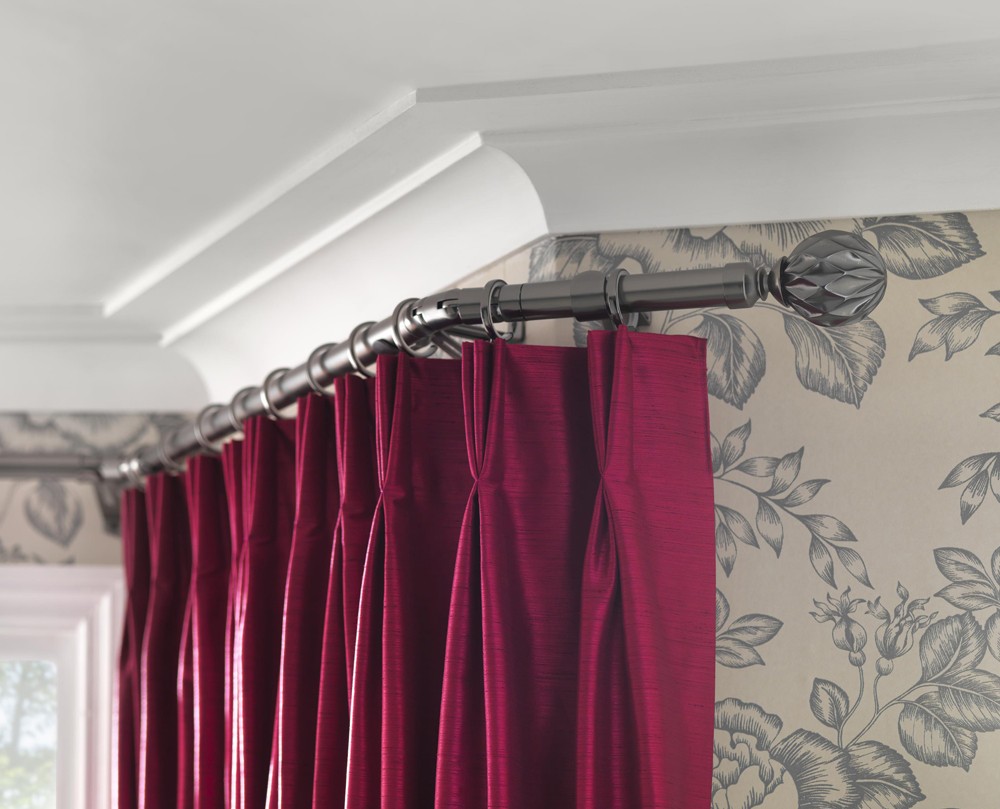
If you would like your curtains to return into the room from the bay window then you will need to look for the bay curtain pole return kits or purchase additional curtain poles, corner joiners, rings & brackets to allow for this. The easiest way is usually a kit though, often referred to as a return bay kit.
A return bay kit creates a reverse corner with additional passing rings & brackets and this allows you to fix it in the normal way a bay pole would be fixed.
View our bay return kits or for more choice read below how to make a bay return kit for ways to do it without a kit.
Not all bay poles have prepackaged return bay pole kits available however you can still use many pole ranges to return into the room, as explained below.
If a prepackaged return kit isn't available for the bay pole you're looking at, often it can be made up by purchasing the components separately.
It depends on the bay pole you have chosen if you can do it. Sometimes it will also require purchasing complete poles if the range isn't sold in component form, leaving you components that are surplus to requirement.
Bay poles with passing rings and brackets can be suitable
The way to do this without a specific kit is to purchase the necessary pole components individually and use them to create a return kit.
Usually you would have an extra two passing brackets, six passing rings and ensure you have a 1m length of additional pole for each side of the bay that you want to return from.
If the pole isn't sold as components then your only choice would be to buy additional bay pole kits. However ensure that you can buy additional passing rings/tracks as these will be required.
Bay poles with tunnel brackets are not suitable for returns
If you purchase a tunnel bracket indirect support bay curtain pole then these won't be suitable for returns, as these bay poles don't allow passing of curtain rings over the brackets, and by adding more poles/brackets to it would prevent the additional poles & rings to pass over any additional brackets.
Metropole with a glider system are suitable
Metropoles that use a glider system are suitable for reverse bends into the room as they're made to measure and the profile can be factory bent inside and outside a bay.
Metropoles are an excellent option as they are very versatile and suitable for many purposes.
Yes, there are plenty of poles or tracks available which can be corded and suitable for bay windows.
When looking you should ensure you are looking at pre-corded ones. The easiest way is to use our site filters for corded bay tracks or corded bay poles.
Any corded pole or track usually cannot hang as heavy curtains as an uncorded pole or track due to the extra friction caused, so be careful to check the weight limits when looking.
Last Updated: 11-Jun-2022
Last Reviewed: 11-Jun-2022
